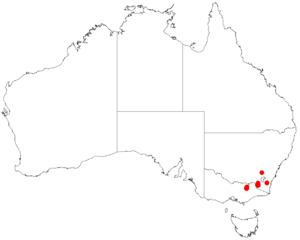Buffalo mint-bush facts for kids
Quick facts for kids Buffalo mint-bush |
|
|---|---|
| Scientific classification | |
| Genus: |
Prostanthera
|
| Species: |
monticola
|
 |
|
| Occurrence data from AVH | |
The Buffalo mint-bush (scientific name: Prostanthera monticola) is a special type of flowering plant. It belongs to the Lamiaceae family, which includes many mint plants. This bush grows only in the higher parts of south-eastern Australia. It's a wide, open bush with reddish, hairy branches. Its leaves are shaped like a spear or a narrow oval. The flowers are a light bluish-green or grey-green, with dark purple-blue lines.
Contents
What the Buffalo Mint-Bush Looks Like
The Buffalo mint-bush is an open, spreading shrub. It usually grows between 0.3 and 2 meters (about 1 to 6.5 feet) tall. Its branches are red, hairy, and often have ridges.
Leaves and Flowers
The leaves are shaped like a spear or an egg, or they can be narrow and oval. They have a groove on their top surface. Each leaf is about 1.5 to 5 centimeters (0.6 to 2 inches) long. They are also about 0.5 to 1.3 centimeters (0.2 to 0.5 inches) wide. A small stem called a petiole connects the leaf to the branch. This stem is about 2 to 5 millimeters long.
The flowers grow one by one where the leaves meet the stem. They sit on a small stalk called a pedicel, which is 2 to 3 millimeters long. This stalk is covered with white hairs. At the base of each flower, there are small leaf-like parts called bracteoles, which are 10 to 18 millimeters long.
Flower Parts
The green sepals are like small leaves that protect the flower bud. They are 10 to 15 millimeters long and form a tube about 5 to 6 millimeters long. This tube has two parts, or lobes, that are 6 to 9 millimeters long.
The petals are the colorful parts of the flower. They are a pale bluish-green or grey-green. You can see dark purple-blue lines, like veins, on them. The petals are 30 to 35 millimeters long and form two "lips."
The lower central part of the flower's lip is 8 to 10 millimeters long and about 10 millimeters wide. The lower side parts are 7 to 8 millimeters long and about 5 millimeters wide. The upper lip is egg-shaped with three faint, small lobes. It is about 10 millimeters long and 12 millimeters wide. This plant blooms during the summer months.
Where the Buffalo Mint-Bush Comes From
The Buffalo mint-bush was officially named and described in 1984. Barry Conn, a botanist, described it in the Journal of the Adelaide Botanic Gardens. He based his description on plants he found in 1980. These plants were collected at Crystal Brook Falls, which is located in Mount Buffalo in Victoria, Australia.
Where the Buffalo Mint-Bush Grows
The Buffalo mint-bush grows in forests on rocky, granitic soils. You can find it in Kosciuszko National Park in New South Wales. It also grows southwards into north-east Victoria, especially in the Mount Buffalo National Park.
Habitat and Altitude
This plant likes to grow at high altitudes, from 530 to 1850 meters (about 1,740 to 6,070 feet) above sea level. It often grows alongside certain types of eucalyptus trees. These include the Alpine ash (Eucalyptus delegatensis), the Snow gum (E. pauciflora), and the Black sallee (E. stellulata).

